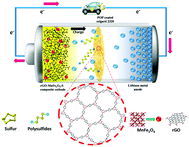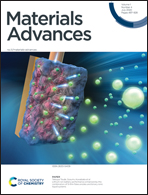A porous organic polymer-coated permselective separator mitigating self-discharge of lithium–sulfur batteries†
Abstract
Lithium–sulfur (Li–S) batteries are considered as futuristic energy storage systems owing to their high theoretical energy density, environmental benignity, and relatively low cost. However, their practical applications are still hampered by the insulating nature of elemental sulfur and the capacity degradation resulting from lithium polysulfide (LiPS) shuttling. Herein, we demonstrate the use of a porous organic polymer-coated Celgard 2320 (POP-CG) separator as the permselective membrane that is capable of not only delivering a higher discharge capacity but also preventing self-discharge of the Li–S cell up to 116 h which is superior compared to earlier reports. This coated membrane not only offers a higher discharge capacity but also exhibited superior wettability and thermal stability. The enhanced electrochemical properties of the lithium–sulfur cell are mainly attributed to the POP coated on the separator which effectively confines polysulfides via chemical interactions.

- This article is part of the themed collection: Advances in Energy Materials


 Please wait while we load your content...
Please wait while we load your content...